Market
We Went to an Art Auction on a Cruise Ship. It Was… Unusual
Take a dive into the wacky world of high-seas art sales.
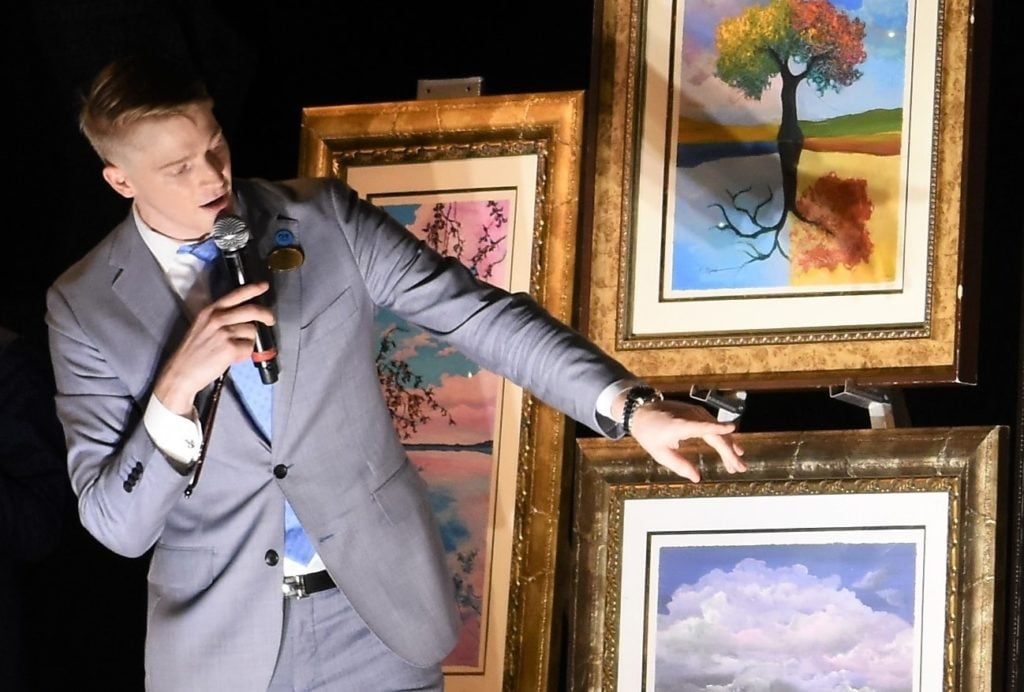
Take a dive into the wacky world of high-seas art sales.

Sarah Cascone

I was lounging poolside, cocktail in hand, when I heard the announcement. The grand finale art auction was about to start.
It was a weekend cruise from Miami to the Bahamas aboard Royal Caribbean’s recently refurbished Navigator of the Seas. Attending the ship’s auction wasn’t part of my plan, but it was beginning to rain, and the rest of my party was still at port. What else was I going to do with the rest of the afternoon? As I entered the event, hosted by cruise-ship auctioneer Park West Gallery, I bypassed the registration table, heading straight for the auction floor, where a waiter was handing out glasses of sparkling white wine.
From the start, it was clear that this was no regular art auction. After a brief spiel encouraging folks to buy art as a legacy to leave to their children, the auctioneer, Robert Borotescu, got down to business.
“I don’t know if you’ve seen Oprah,” he said. “We have some surprises under the chairs.”

A Park West art auction in the Star Lounge on Royal Caribbean’s Navigator of the Seas. Courtesy Cruise Critic.
Cue a frenzy as the few guests in the room rushed to upturn every seat cushion. There were no car keys to be found, but there were $100 certificates for discounts on winning bids.
Borotescu, a dark-haired Romanian man in his mid-to-late 30s, endeared himself toward the crowd by offering additional raffle tickets for $100 credits throughout the auction. After every lot, he would encourage attendees to wave their auction paddles (or bid cards, in the parlance of Park West), promising the discount to whoever was first in the air. Inevitably, he’d credit two, three, or even four bidders every time, making everyone feel like a winner.
With his pleasantly urbane accent, Borotescu set his audience at ease, acknowledging that they probably never had the time to visit art museums and galleries. But they were here now, and it was his job to make sure that they went home with something they absolutely loved.
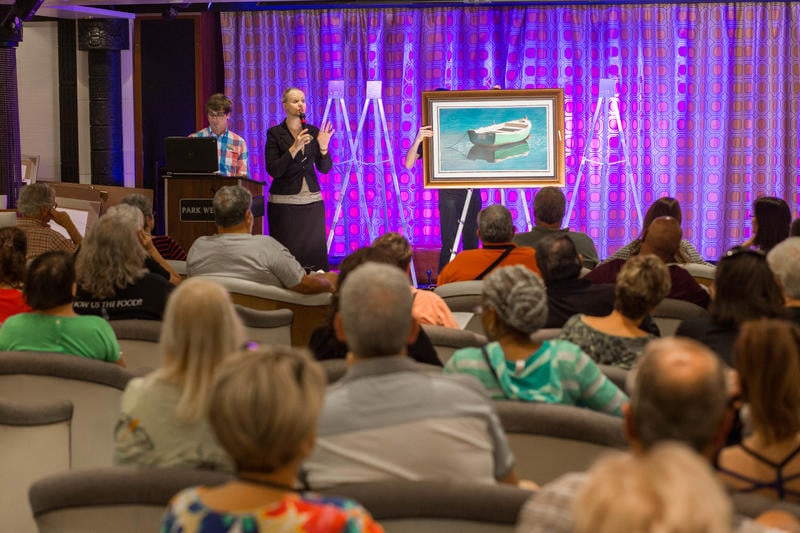
A Park West art auction in the Star Lounge on Royal Caribbean’s Navigator of the Seas. Courtesy Cruise Critic.
Founded in 1969 by Albert Scaglione, Park West boasts some impressive-sounding sales numbers. Borotescu told us that the company operates on 100 cruise ships, and claimed that the art aboard the Navigator of the Seas alone was worth $3 million. Representing some 200 artists, the company holds 1,200 auctions every month.
“You tell me another gallery that sells so much art in a month,” Borotescu boasted to his audience, noting that the company even has its own art museum just outside Detroit.
But unlike most art world organizations, Park West seems to hire employees with largely non-art backgrounds. Borotescu’s LinkedIn lists six years in fine jewelry and watch sales at Louis Vuitton Moet Hennessy before joining the company. A quick perusal of resumes of other auctioneers and art directors at the company yields unconventional experience in HVAC, used car sales, fitness instruction, and Royal Caribbean’s beverage team, to list just a few.
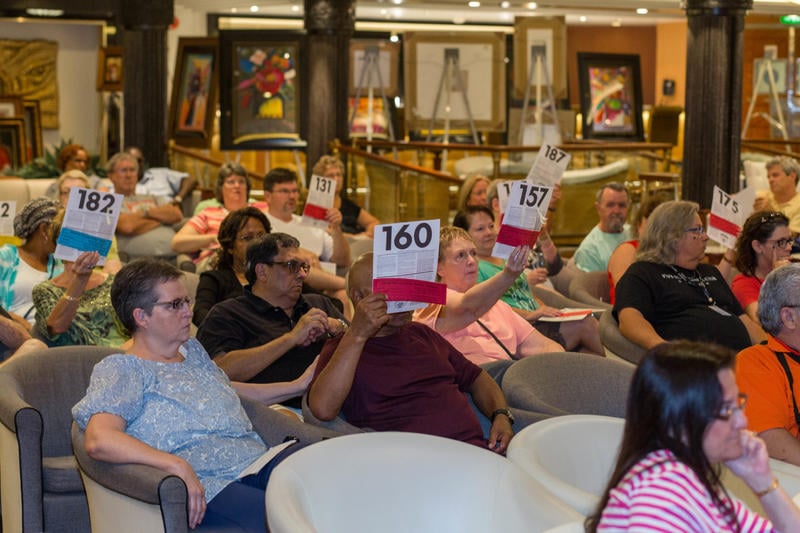
A Park West art auction in the Star Lounge on Royal Caribbean’s Navigator of the Seas. Courtesy Cruise Critic.
And where traditional auction houses operate on the secondary market, selling works consigned by private collectors, Park West specializes in what it calls “graphic works”: Mass-produced reproductions of original paintings, signed by the artist and released in limited editions. Some are giclée prints—a fancy term for high-quality inkjet prints. Other pieces might look like paintings, but these more expensive offerings are often merely hand-embellished, with brushstrokes layered over a printed image to give it a more “authentic” feel.
“They look like a unique one-of-a-kind, they feel like a unique one-of-a-kind—just [at] the fraction of the price,” Borotescu explained before kicking off the sale. Later, he said: “If we look at the Oxford Dictionary of Art, every single artwork that can be traced back to the artist, or was created under the artist’s supervision, is considered to be an original work of art.” He noted that the Park West collection does not include posters, because “they have no value.”
Of course, practically all these works are anything but unique, and most of the time, you won’t even take home the exact work you’re bidding on. Park West will ship you a functionally identical copy from its warehouse, rather than going through the trouble of turning over the on-board stock, according to Bloomberg Business. The publication also reported in 2016 that since 2008, Park West had been subject to nearly a dozen lawsuits alleging abusive sales practices.
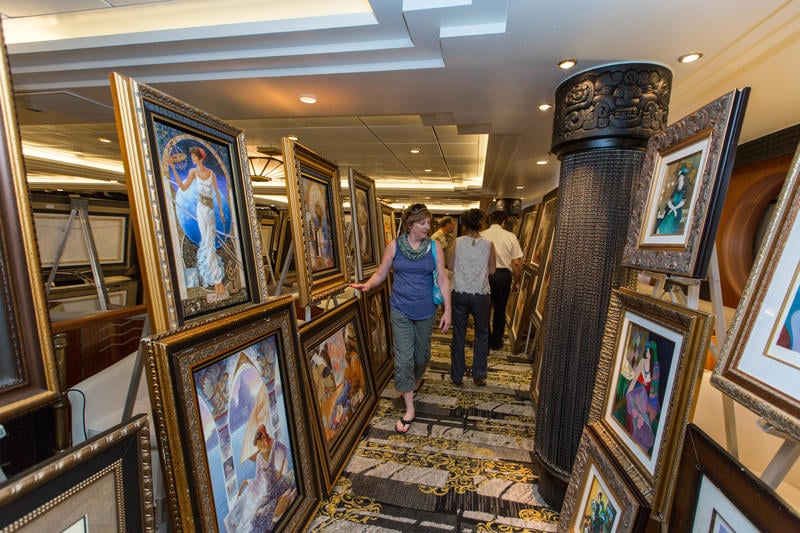
A Park West art auction in the Star Lounge on Royal Caribbean’s Navigator of the Seas. Courtesy Cruise Critic.
Before the opening lot, Borotescu instructed the staff to open the side aisles where the art was on view to allow collectors to peruse the works on offer and to place stickers next to the works they were particularly interested in. They could also talk to his associate, Gabby, who he referred to as “the love of my life” (on board love affairs between Park West employees are celebrated on the company website) about securing a lower, pre-auction reserve price for any pieces they were dead set on taking home, or to discuss package pricing for groups of works.
The bidding kicked off with a piece by Peter Max, a well-known Pop artist who met Scaglione, Park West’s founder, back in the late 1960s, and has been represented by him ever since.
That arrangement has become strained in recent years, as Max has suffered from dementia and stopped painting, allegedly signing pieces churned out by assistants. According to the New York Times, the artist’s daughter has sued the gallery for underpaying for his works, and Park West has returned the favor with a breach of contract suit.
“This is one of the gems we have on the Navigator of the Seas,” Borotescu told the crowd, claiming that the “printed painting on canvas” was valued at $23,500, but that he could start the bidding at $20,000. Less than 30 seconds later, the work was sold for $20,700.
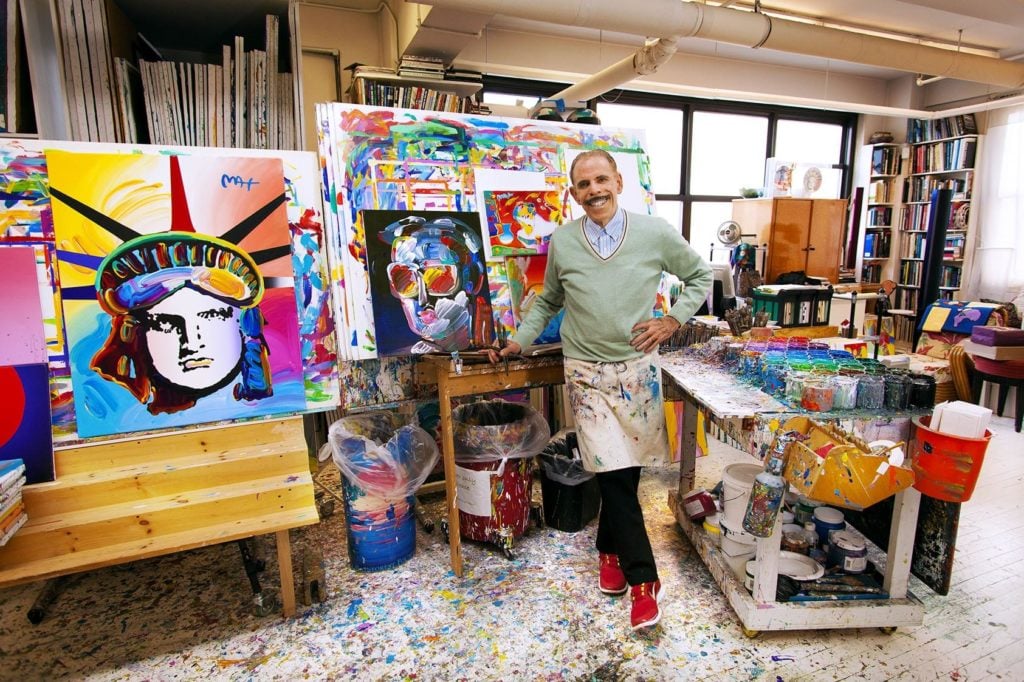
Peter Max. Photo courtesy of the artist.
Max has decades of experience exhibiting at international museums. The highest auction record for a work of his is $53,125, according to the artnet Price Database. But that’s an outlier. Among nearly 2,000 records, only two other works by the artist sold by a serious auction house went for more than $20,000.
Other artists on offer had decidedly less impressive CVs. Borotescu proudly proclaimed that Park West is the only gallery to represent David “Lebo” Le Batard, noting that the artist is known for his paintings of cats and owls. This didn’t seem like much of a selling point, but that didn’t stop the auctioneer from presenting a group of his works. Later, another artist, Slava Ilyayev, was praised for working exclusively with a palette knife. And then there was someone named Gene Moore. “He has a lot of creativity,” Borotescu insisted. “We have to agree that he has a lot of creativity.”
The relative obscurity of most of the artists—all of them seemed to be men—might be part of the reason that the auction relied heavily on gimmicks, presumably designed to encourage the audience to get in on the action and make a bid.
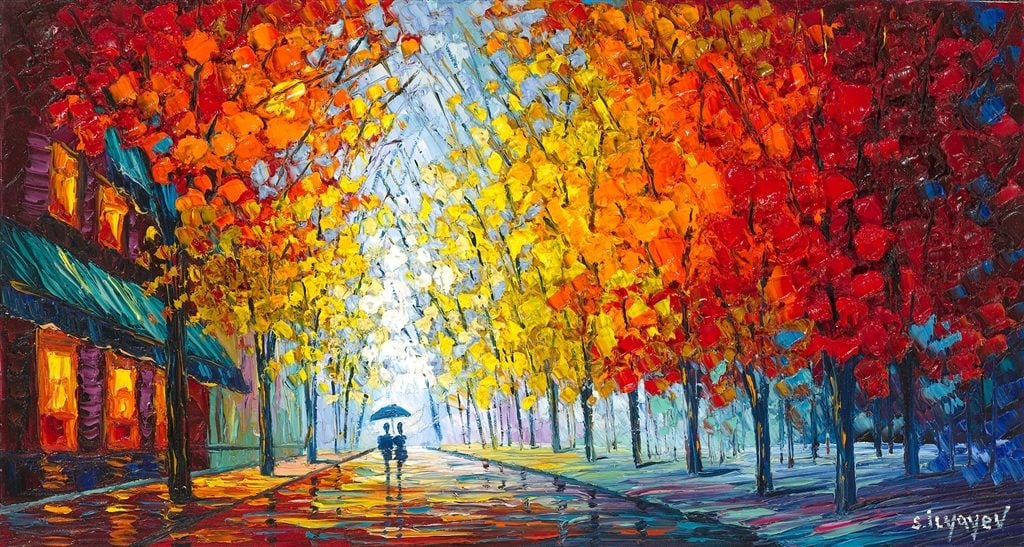
Slava Ilyayev, You Will Love Again (2018). Courtesy of Park West Gallery.
Every attendee was encouraged to enter a free raffle to take home a massive, unframed Thomas Kinkade. And if you signed up for the Park West “collector’s card,” used exclusively to make purchases with the company, you were promised a free work by an unknown-to-me Croatian artist named Marko Marković.
One gimmick in particular stood out: A pair of works presented turned away from the audience, and sold as one lot, without any idea of what they looked like. “They are going to be two of the most gorgeous works of art that anyone has ever seen,” Borotescu promised the audience. “Once you turn it around, if it’s something you don’t like, you don’t have to keep it.”
The prints turned out to be by an artist named David Najar, one of the most frequently featured artists of the night, with numerous lots featuring his generic, highly saturated compositions of trees and skies. The mystery lot hammered down for $1,490. Borotescu generously tossed in a third work by the artist (an edition of it sold as part of an earlier lot) to round out the set.
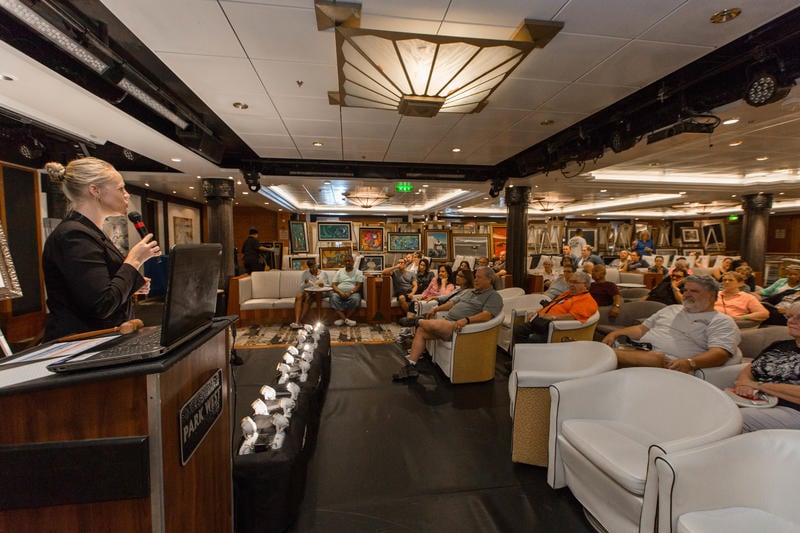
A Park West art auction in the Star Lounge on Royal Carribbean’s Navigator of the Seas. This photo was posted publicly on the Cruise Critic, a Yelp-like website, by a user.
And then there was Tweety.
Borotescu never named the artist responsible for designing the tiny print, relying on the Looney Toons character’s name recognition and the picture’s very loose connection to an Old Master painter to secure the sale: “Rembrandt was doing etchings 500 years ago,” the auctioneer intoned. “Tweety was done using the same technique.”
Supposedly, the artwork, which was just a couple inches high and therefore impossible to see from across the room, was valued at $549.
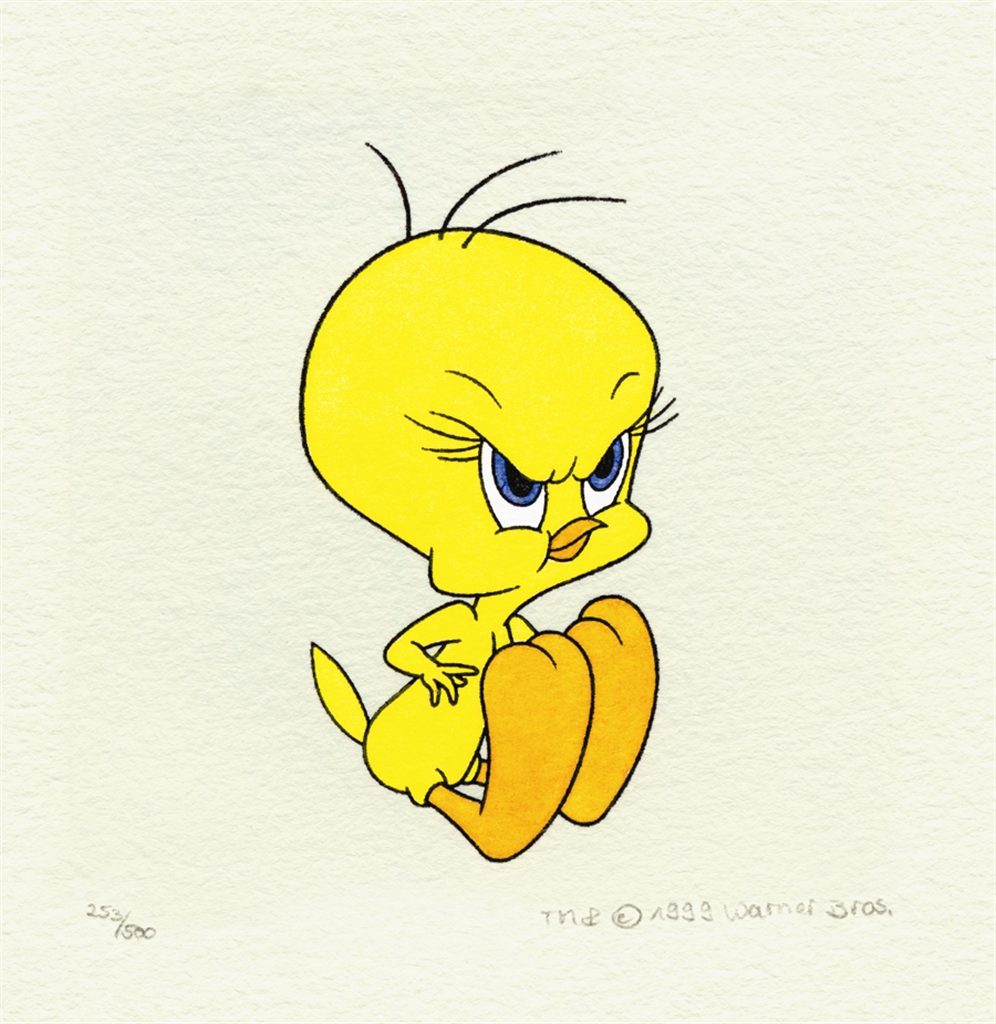
Warner Bros. Studios, Tweety (1999). Courtesy of Park West Gallery.
“Let’s have some fun,” Borotescu suggested, asking everyone in the room to hold up their bid card. He opened the bidding at just $20. Two thirds of the crowd dropped out when he raised the price to $40, and suddenly the auctioneer slammed down the hammer, selling the cartoon bird to a handful of guests.
Amused by the over-the-top ‘Sotheby’s for Dummies’ spectacle, I felt compelled to make a video as Borotescu sold one of the lots. Scanning the room in search of bid cards, the auctioneer quickly spotted me, and didn’t skip a beat as he intoned, “no recording, no pictures please.”
Within minutes, a security guard had been dispatched, warning me that the guests purchasing works of art had a right to their privacy and that I was not allowed to make recordings. There was no point in arguing. In 2009, the Independent reported that one passenger was removed from a cruise for warning guests to careful buying expensive art from Park West. I knocked back another glass of champagne and took my leave.